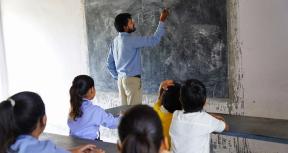Public support for agriculture has historically been directed towards the production of staple foods, such as rice and wheat, or export commodities. In many developing countries, this often creates an uneven playing field for producers, who are left with limited possibilities to diversify into locally-adapted and more nutritious products that do not receive public support, but for which there is demand. While the World Bank Group has long supported efforts to increase the productivity and diversification of agrifood economies, a recent evaluation by the Independent Evaluation Group (IEG) of this support over ten years (2010-20) found that it is insufficiently spread to support diversification toward such products. This blog summarizes the main findings and lessons for increasing diversification of agrifood systems in ways that are more sustainable and inclusive.
Challenges to diversification
In an effort to enhance national food security, governments often provide support for agriculture which can affect production and marketing decisions. This may include preferential investments in research and development, input subsidies, price support, and assured prices for certain commodities. When most public support is going to a few favored staple commodities, producers lack incentives to increase the production of products that do not benefit from large support, such as fruits, vegetables, pulses, dryland cereals, and livestock. This can be the case even when consumer demand is increasing and when expanding the production of undersupplied foods could generate high social benefits. For example, India’s public support to agriculture since the Green Revolution has emphasized production and marketing of staple cereals; public procurement is largely limited to paddy (rice) and wheat produced in few states although recent policies aim to provide price support for more diverse food crops.
Diversifying into more nutritious and undersupplied products is essential to meet the growing demand for affordable healthy diets, including fruits and vegetables. It can also provide higher incomes and help smallholders be more market-oriented in their approach to production. To be sustainable, such diversification needs to be underpinned by climate-smart approaches that reduce the environmental footprints by making efficient use of resources, such as land and water, and by protecting biodiversity.
Several recent interventions from the World Bank have aimed to increase diversification to high value products but more effort is needed. In Uzbekistan, for example, the Bank is supporting a shift from cotton and wheat toward more diversified systems that are resilient to climate shocks. Cotton and wheat consumed 72% of arable land and 90% of irrigation water and agricultural public expenditures but generated only 23% of total agricultural output. In the Gambia, the Commercial Agriculture and Value Chain project supported rice, vegetables and fruit (mango) value chains.
The World Bank’s support contributes to national food security but has not been sufficiently spread to support diversification towards higher-value and more nutritious products that are often undersupplied. While Bank financing for agriculture has contributed to strengthening national food security, more can be achieved in supporting diversification beyond key staples and livestock. Only about 4% of the World Bank’s product-targeted projects supported the production of fruits and vegetables and 11% supported food legumes. Similarly, most of the Bank’s support for livestock production focused on dairy (27%) and fish (34%). Only about 3% of livestock projects explicitly supported production of small ruminants (sheep and goats) that offer income-generating opportunities for low-income households in rainfed and drought-prone environments.
Lessons for supporting sustainable diversification
The World Bank’s support for diversification towards high value products has been particularly challenging in less favorable areas. These areas include drought-prone rainfed areas without adequate irrigation systems or have limited access to markets and services. In addition to addressing these constraints, success in supporting diversification toward undersupplied and higher-value products will require the following:
- Access to finance: Access to finance is a key driver of production of high value commodities. Farmers and Small and Medium Enterprises (SMEs) can invest in inputs and technologies when they have access to credit at the amounts that they need and at rates they can afford. When financing is limited, matching grants can be used to facilitate investments in critical inputs and processes. For example, Vietnam’s Livestock Competitiveness and Food Safety project (LIFSAP) provided matching grants to farmer groups for investments in good animal husbandry practices, including waste treatment facilities and construction of over 17,000 biogas digesters to reduce methane emissions. Support to poultry and pig farmers strengthened links with buyers, increasing their incomes, and facilitating diversification into more sustainable livestock production.
- Food safety and quality standards: The World Bank has supported several interventions to strengthen food safety and quality standards, allowing farms and firms to produce high value and perishable commodities. For example, Vietnam’s LIFSAP project supported the upgrading and improvement of 370 slaughterhouses and 572 meat markets. This promoted adoption of food safety and waste management practices of animal production, processing, and marketing facilities. LIFASP also helped build the capacity of poultry and pig farmers, and slaughterhouses and traders operating in wet markets. This supported the strengthening of institutions that helped towards better delivery of veterinary services and modernization of food safety standards. Similarly, Montenegro’s Institutional Development and Agriculture Strengthening Project (IDASP) provided financing and helped build the capacity of eligible farmers and agro-processors to strengthen food safety standards and meet the European Union pre-accession requirements.
- Production and market infrastructure: Complementary investments in market infrastructure and equipment, such as collection points, warehousing, cold storage, and transport, are particularly important to diversify production into perishable high-value products. In India, the National Dairy Support Project (NDSP) supported small-scale dairy farmers and cooperatives and built village-based milk procurement systems with milk-quality testing. These interventions allowed small-scale farmers to participate in more lucrative, organized dairy value chains, increase milk prices, and reduce wastage. The project complemented this by helping build the capacity of the farmers and providing them better access to technologies and services to increase their productivity. This also included digital innovations that reduced costs and helped provide optimal information and services to users.
- Enabling policy environment: Diversification into high value products requires the right policy environment, including enforceable laws and regulations. In more advanced economies agriculture historically benefits from substantial public support, costing about US$640 billion per year worldwide, generating hidden social and environmental costs. In order to reduce these latent costs and create a level playing field for producers, there is merit in repurposing these biased policies to support the development of green, resilient, and inclusive agrifood economies. This also includes sustainable diversification into high value products that generate multiple social and environmental benefits. Such smart-repurposing could provide win-win solutions for reducing poverty (SDG1), improving food security, and reducing the cost of healthy diets (SDG2), while reducingglobal emissions for mitigating climate change (SDG13) and generating other social and environmental benefits. Re-aligning incentives would require: (a) removing policies that are biased against diversification that provides multiple benefits; and (b) removing restrictions on land use tied to specific crops to allow diversification (example through multiple cropping or rotations).
The above lessons are valuable in supporting clients in diversifying into high-value and more nutritious products in ways that are sustainable and inclusive of small producers and value chain actors. This can also help find viable solutions to address the growing challenges for improving global food and nutrition security
See also: Building inclusive, productive, and sustainable agrifood systems | Complementary Interventions for Agrifood System Development – Insights and Lessons








Add new comment